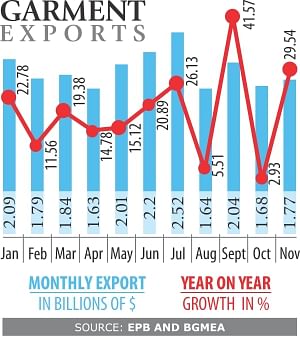The year of adversity, resilience

Resilience best sums up 2013 for the garment sector, the country's main foreign currency earner: hit by one setback after another and yet it managed double-digit growth.
Between January and November, the sector raked in $21.22 billion, up 19.10 percent from the previous year.
Just as the sector was recovering its bruised reputation from the Tazreen fire of 2012, came the fire at Smart Export Garments on January 26, killing eight. And barely three months later, Rana Plaza, an eight-storey building which housed five garment factories, collapsed.
The worst industrial accident in the nation's history, it put the sector right under the microscope the world over and prompted many international buyers to reconsider their sourcing options and the US to suspend its trade privileges for Bangladesh.
The sector then witnessed labour unrest over wage rise which lasted for months and brought about suspension of production in more than 300 garment factories in Ashulia and Savar.
The agitated workers demanded a 170.5 wage rise but the garment owners were willing to increase their payroll by 20 percent. After protracted negotiations, a salary increase of 77 percent was agreed upon on November 21, which restored normalcy to the sector.
A few days later on November 26, during the peak shipment season, the opposition alliance embarked on its demonstration programme which involved non-stop countrywide blockade. Several goods-laden trucks were burnt on their way to the Chittagong port, prompting many transport owners to take their vehicles off the roads or increase the fares fourfold.
Lastly, the sector had to deal with the steep decline in value of the Indian rupee, the currency of its major competitor on the global market, and appreciation of local currency against the dollar, both of which eroded its competitiveness to a certain extent.
“Yes, we have overcome a very difficult year,” said Atiqul Islam, president of the Bangladesh Garment Manufacturers and Exporters Association.
He said that the following year will pan out to be as challenging if the political turmoil spills over into 2014.
“We need a peaceful solution to the political crisis for the sector. We are losing our competitiveness on the international front and the domestic turbulence is only making things harder for us.”
Meanwhile, all the criticism following the twin industrial disasters of Tazreen fire and Rana Plaza yielded some constructive actions.
Two platforms were formed consisting of retailers from North America and Europe with the aim to improve the working conditions in the country's garment factories. The government, too, took a series of measure to that end.
The European Union is closely monitoring the developments, until the middle of 2014. If satisfied, it will continue with the trade privileges for the country – which enables duty-free entry of garment products into the bloc.

 For all latest news, follow The Daily Star's Google News channel.
For all latest news, follow The Daily Star's Google News channel. 



Comments